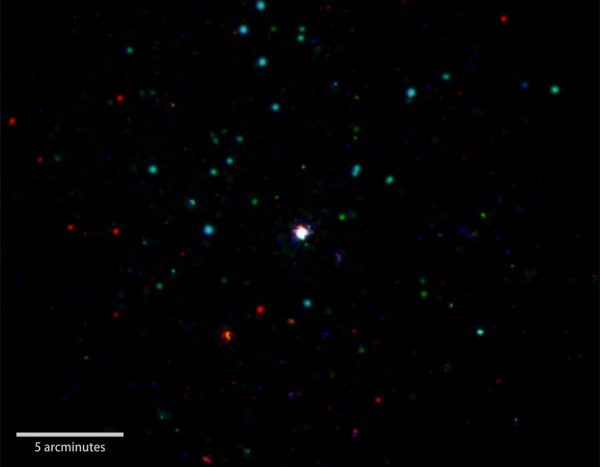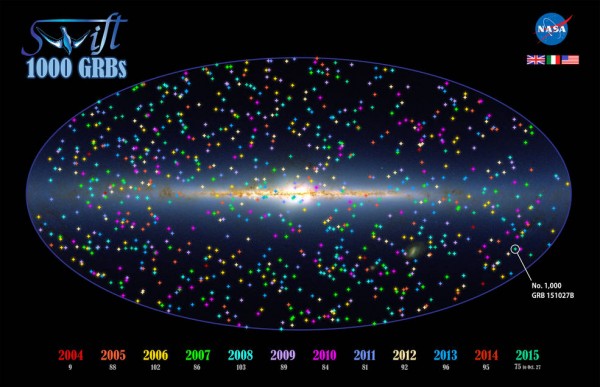
NASA announced on November 6, 015 that its Swift spacecraft has detected its 1,000th gamma-ray burst (GRB). Wow! That’s a lot of power, times 1,000.
In fact, gamma-ray bursts are the most powerful explosions yet observed in the universe. They are flashes of gamma rays – seen so far to last from 10 milliseconds to several hours, and often lasting a minute or less – thought to be associated with distant galaxies, possibly with the collapse of a massive star and the birth of a black hole. They occur somewhere in the sky every couple of days, NASA said.
Swift’s Burst Alert Telescope detected its 1,000th gamma-ray burst as a sudden pulse of gamma rays coming from the direction in our sky to the constellation Eridanus the River. The 1,000th gamma-ray burst came shortly before 6:41 p.m. EDT (1041 UTC) on October 27, 2015. Astronomers call the event GRB 151027B, after the detection date and the fact that it was the second burst of the day.
NASA said that Swift automatically determined its location, broadcast the position to astronomers around the world, and turned to investigate the source with its own X-ray, ultraviolet and optical telescopes. The NASA statement added:
Astronomers classify GRBs by their duration. Like GRB 151027B, roughly 90 percent of bursts are of the “long” variety, where the gamma-ray pulse lasts more than two seconds. They are believed to occur in a massive star whose core has run out of fuel and collapsed into a black hole. As matter falls toward the newly formed black hole, it launches jets of subatomic particles that move out through the star’s outer layers at nearly the speed of light. When the particle jets reach the stellar surface, they emit gamma rays, the most energetic form of light. In many cases, the star is later seen to explode as a supernova.
“Short” bursts last less than two seconds — and sometimes just thousandths of a second. Swift observations provide strong evidence these events are caused by mergers of orbiting neutron stars or black holes.
Once a GRB is identified, the race is on to observe its fading light with as many instruments as possible. Based on alerts from Swift, robotic observatories and human-operated telescopes turn to the blast site to measure its rapidly fading afterglow, which emits X-rays, ultraviolet, visible and infrared light, and radio waves. While optical afterglows are generally faint, they can briefly become bright enough to be seen with the unaided eye.

Five hours after Swift first spotted GRB 151027B – and broadcast its location to other astronomers – Earth’s rotation carried the burst location into view for the European Southern Observatory (ESO) in Paranal, Chile. NASA said:
There a team led by Dong Xu of the Chinese National Astronomical Observatories in Beijing captured the afterglow’s visible light using the Very Large Telescope’s X-shooter spectrograph. The ESO observations show that light from the burst had been traveling to us for more than 12 billion years, placing it in the most distant few percent of GRBs Swift has recorded.
Neil Gehrels, the Swift principal investigator at NASA’s Goddard Space Flight Center in Greenbelt, Maryland, said:
Detecting GRBs is Swift’s bread and butter, and we’re now at 1,000 and counting. The spacecraft remains in great shape after nearly 11 years in space, and we expect to see many more GRBs to come.
Swift was launched on November 20, 2004.

Bottom line: NASA’s Swift spacecraft detected its 1,000th gamma-ray burst on November 6, 2015.











